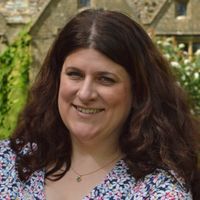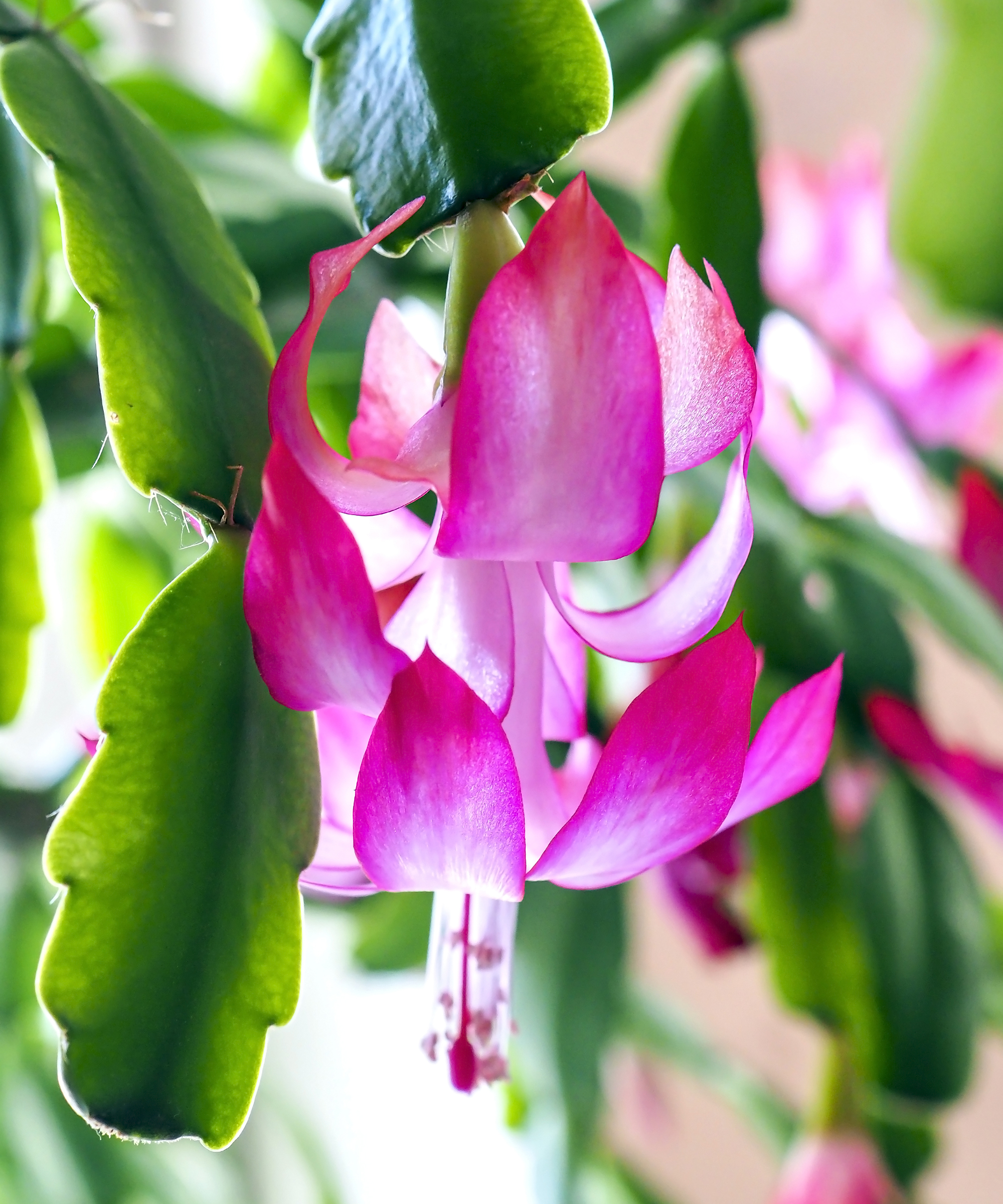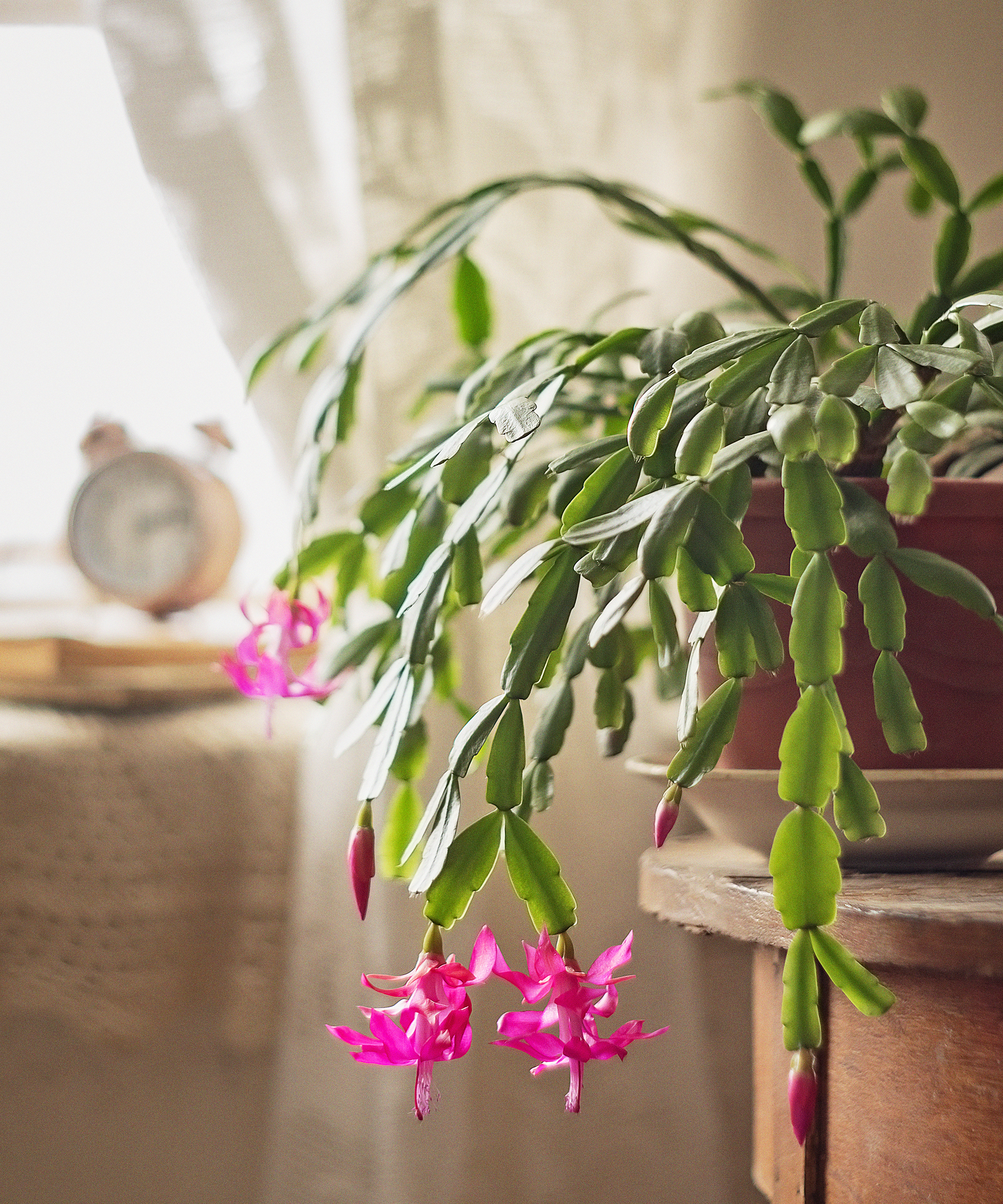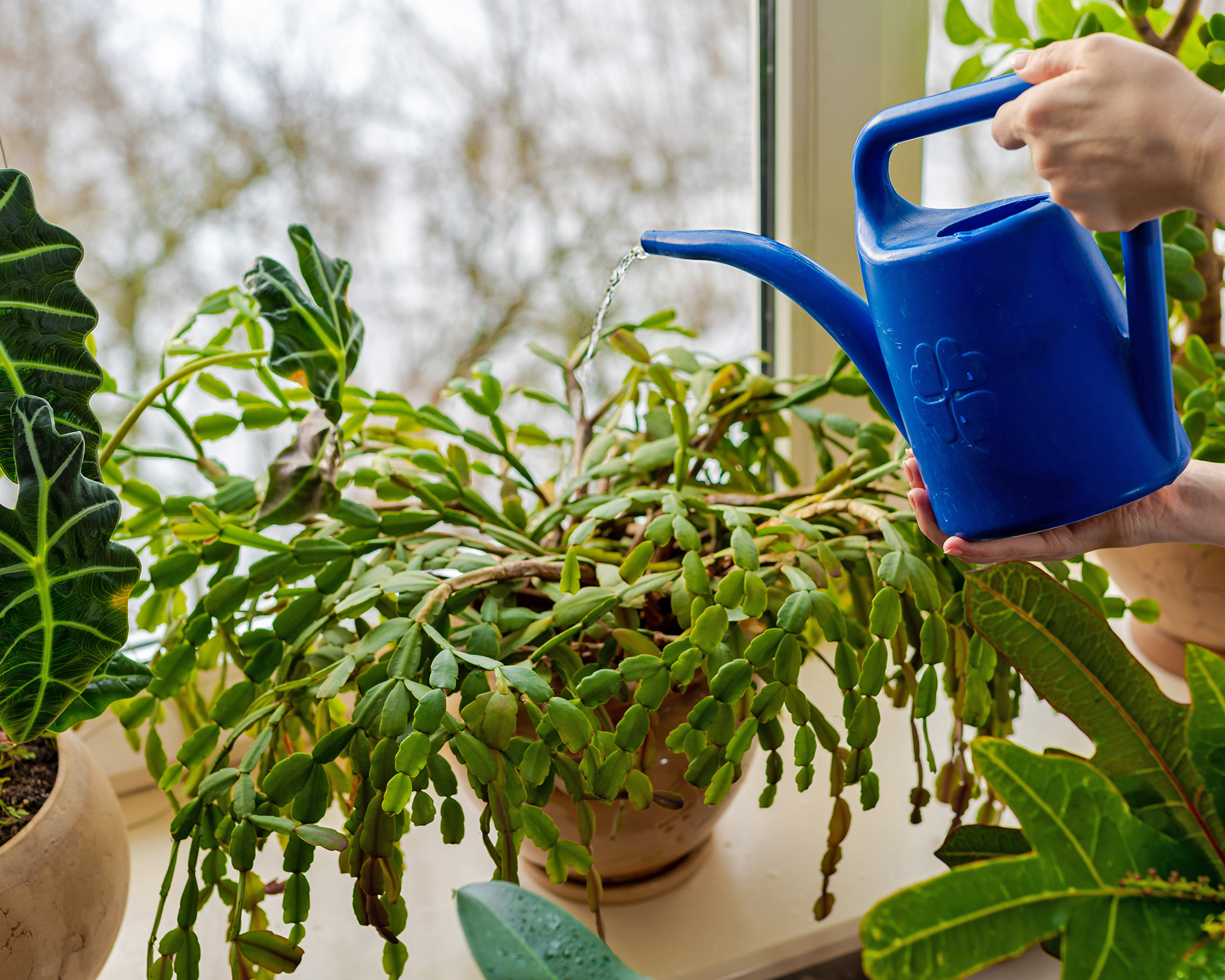Christmas Cactus Care: How to Grow and Make Schlumbergera Bloom Indoors
Brighten winter with the vibrant blooms of a Christmas cactus. Learn how to care for this tropical beauty and keep it flowering year after year.

Amy Draiss

The Christmas cactus (Schlumbergera x buckleyi) is a much-loved festive plant that puts on a spectacular floral display over the holidays. Unlike desert cacti, it hails from the humid tropical forests of Brazil, meaning Christmas cactus care is quite different from that of succulents adapted to dry environments.
There are three types of holiday cactus, and though "Christmas cactus" is often used collectively, the plant does differ slightly from its cousins, the Thanksgiving cactus and Easter cactus. In particular, the spiky-leaved Thanksgiving cactus is the one most commonly sold under the Christmas label. If you’re unsure which type you own, don’t worry. Christmas and Thanksgiving cactus care is almost identical, and both rely on the same light and temperature cues to bloom. Easter cactus care is a little more involved, however, as the plants are more particular.
With proper care, the Christmas cactus can live for generations – sometimes over a century – making it a true family heirloom. Follow the advice below to keep your plant in perfect health and flowering on cue each year.
Quick Christmas Cactus Facts
Botanical Name | Schlumbergera x buckleyi |
Plant Type | Tropical epiphytic succulent |
Height | 12 to 24 inches (30 to 60 cm) |
Spread | 12 to 36 inches (30 to 90 cm) |
Light | Bright, indirect or filtered |
Soil | Well-draining; slightly acidic (pH 5.5 to 6.2) |
Hardiness | USDA zones 9 to 11. (Not in the US? Convert your growing zone) |
Flowers | Winter |
Native Range | Southeastern Brazil |

Identifying a True Christmas Cactus
Many plants sold as "Christmas cacti" are actually varieties of the more common Thanksgiving cactus (Schlumbergera truncata), which blooms several weeks earlier. The true Christmas cactus (Schlumbergera x buckleyi) is a hybrid, and you can tell it apart by looking at its stems, flowers, and growth habit.
Here’s a quick guide to identifying your plant:
- Leaves: The stem segments of Christmas cactus are smooth, with rounded, scalloped edges. In contrast, Thanksgiving cacti have spiky leaves with pointed "claws" on the edges.
- Growth habit: Christmas cactus has stems that arch gracefully, while Thanksgiving cacti are typically more upright and stiff.
- Bloom time: True to its name, the Christmas cactus blooms late December through January, while the Thanksgiving cactus flowers between November and early December.
- Flowers: Christmas cactus flowers are magenta to pink in color and hang down like pendants. Thanksgiving cacti flowers are more tubular, in shades of pink, red, or white.
- Anthers: Christmas cacti have purplish anthers (the part of the stamen that holds pollen), while Thanksgiving cacti have yellow anthers.
You may also see an Easter cactus (Rhipsalidopsis gaertneri, formerly Schlumbergera gaertneri), but it's easier to tell apart due to its spring bloom time (March-May) and distinctive star-shaped flowers.
This guide focuses on the care for the true Christmas cactus, though the needs of other holiday cacti are similar.
Sign up for the Gardening Know How newsletter today and receive a free copy of our e-book "How to Grow Delicious Tomatoes".
Christmas Cactus Care Guide
Native to the coastal mountains of Brazil, the Christmas cactus grows beneath the canopy of tropical forests. It is an epiphyte plant, meaning it lives in tree branches and rock crevasses, anchoring itself using aerial roots. Rather than soil, it absorbs moisture and nutrients from surrounding humus and plant debris.
When grown indoors, Christmas cacti take in moisture and nutrients from their potting mix. The better you can mimic their native rainforest conditions – through the right temperature, light, feeding, and moisture – the healthier your plant will be.
That might sound like a lot, but these plants are surprisingly easygoing. They are well-suited to the home environment and only need to follow a few simple rules to get a good show of flowers.

Christmas Cactus Light Requirements
In their natural environment, Christmas cacti are understorey plants that receive mostly filtered sunlight. So, when grown as houseplants, the best position is near a bright window but with protection from strong afternoon sun. An east or south-east window is ideal, but the plants can be grown in south-facing rooms if a sheer curtain is used to filter the light.
Christmas cactus light requirements are most important in the 6 to 8 weeks leading up to flowering. At this time, the plants require a long, uninterrupted period of darkness each night. If you want blooms for Christmas, then in early to mid October, place it in a room where it can experience 12-14 hours of total darkness each night, or cover it with a box or breathable bag.
How Often to Water a Christmas Cactus
Christmas cactus moisture needs are quite different from those of a desert cactus. These are tropical succulents that experience more rainfall and humidity. When rainwater is scarce, they take moisture from dew and surrounding organic matter. Sites like these aren’t naturally moist all the time, nor are they extremely dry.
Watering Christmas cactus should be frequent in the spring and summer when growth is active, and reduced in the cooler seasons. Aim for every 1 to 2 weeks in spring and summer and every 2 to 3 weeks in fall and winter. But be guided by the feel of the potting mix, allowing it to dry out somewhat between watering intervals, but not completely.
Avoid being too liberal with watering, which will lead to stem and root rot, and can also attract pests like fungus gnats. If the plants are looking yellow and wilting and the soil is wet, then you need to take action. Overwatered Christmas cactus care involves removing the plant from its container, rinsing it, and trimming rotten roots, then allowing it to dry out before repotting.
Using a moisture meter will take the guesswork out of watering – this Yamron 4-in-1 Soil Moisture Meter from Amazon also tests temperature, soil pH, and light levels to ensure houseplants are happy.

Temperature & Humidity
Similar to their native environment, Christmas cacti thrive in moderate warmth and average to high humidity levels indoors. During the spring and summer, the ideal daytime Christmas cactus temperature is between 65 and 75°F (18 to 24°C), with nighttime temperatures of 60 to 65°F (15 to 18°C).
However, to force flowering, plants require a cooler period during the fall, with daytime temperatures of 60 to 70°F (15 to 21°C) and nighttime temperatures of 55 to 60°F (12 to 15°C). In particular, plants should be cool overnight at this time, as night temperatures above 70°F (21°C) will inhibit bud development.
In September or October, relocate your cactus to a cooler location in the home to help signal to the plant that it’s time to bloom. You can move it back again once it has begun flowering, but avoid exposing the plant to extreme temperature changes, cold drafts, or unvented heaters, which will cause bud drop.
Christmas cacti thrive with 50 to 60% humidity, which is higher than the average home interior. Placing a tray of pebbles filled with water beneath the container is a good way to increase humidity for houseplants. The evaporation of this water will add moisture to the ambient air without exposing the roots to excess water. Alternatively, use a small humidifier, like the Homedics Portable Humidifier from Amazon.
Bear in mind that too much stagnant humidity can cause fungus in cold rooms

Best Fertilizer for Christmas Cactus
From spring through to the end of August, feed your holiday cactus once a month. The ideal Christmas cactus fertilizer is a balanced product designed for houseplants, such as this Gardenwise 10-10-10 All Purpose Plant Food on Amazon. If using a product with an NPK of 20-20-20, you should dilute the feed to half strength to avoid overfertilizing, which will damage the fine, shallow root system.
In the fall, when the flower buds begin to form, either stop fertilizing or switch to a low-nitrogen formula that is higher in phosphorus and potassium, like this CZ Garden Organics 4-10-10 Bulb and Bloom Fertilizer. This will boost flower development and prompt your Christmas cactus to bloom by holiday time.
In addition to a balanced fertilizer, an occasional application of Epsom salts dissolved in water (one teaspoon of salts in one gallon of water) will fuel the plant's high magnesium requirements. Do this no more than once a month, and not in the same week as fertilizing.
Care After Flowering
The Christmas cactus will bloom for several weeks – as many as eight weeks, ceasing in early to mid-winter.
Deadheading spent blooms will encourage the plant to produce more flowers, then once it's finished you should remove the remaining blooms.
Continue creating seasonal conditions for plant dormancy, and you can encourage a second flush of flowers in late winter to early spring. To do this, keep the cactus in a cooler part of the house with 13-14 hours of darkness overnight, and water minimally.
Plants will resume active growth in the spring, once blossoming has finished. At this stage, you can start fertilizing and slightly increase watering frequency.

How to Prune a Christmas Cactus
While Christmas cacti don't need much pruning, an occasional tidy-up after flowering will make the plant appear fuller and encourage a more attractive shape. You should also remove any damaged or diseased areas to promote good health. Always use sharp, sterile hand pruners and make each cut at a section joint.
If you are pruning a Christmas cactus to reduce its size, then remove no more than one-third of the plant each year to avoid causing too much stress. However, if your plant has become dried up, straggly, and looks dead, hard pruning may be the only way to save it. Cut it all the way back to the soil level, and water it lightly each day. It will probably surprise you by coming back to life.
Repotting a Christmas Cactus
Christmas cacti need to be repotted every two to four years, as over time they deplete the soil of nutrients and outgrow their container. Learning how to repot Christmas cactus plants is the same process as for most other houseplants. The key things to bear in mind are that you should only go up one pot size, as the succulents thrive when pot-bound. Also, the new container must have adequate drainage holes, to prevent waterlogging.
The best time to repot Christmas cacti is after the plants have bloomed, in late winter or early spring. Unless the plant is in poor health, it should not be attempted in the fall, as it may disrupt flowering.

Best Potting Soil for Christmas Cactus
Christmas cactus soil should be a well-draining, loamy mix with good fertility. It should also have a slightly acidic soil pH – 5.5 to 6.2 is ideal.
You can use a soil mix formulated for cacti and succulents, like Miracle-Gro's Cactus, Palm and Citrus Potting Mix, available on Amazon, or make your own potting medium. A simple recipe is three parts houseplant potting soil mixed with two parts perlite or vermiculite. Once you get more experienced at making your own blend, you can experiment by incorporating peat moss or pine bark.
Repotting Step-by-Step
- Carefully slide the cactus out of its old pot. If it's stuck, gently squeeze the sides of the pot to loosen it.
- Gently tease the root ball with your fingers to loosen any compacted roots.
- Add a layer of fresh, well-draining potting mix to the bottom of the new pot (which should be only slightly larger than the old one).
- Place the plant in the new pot. Check that the top of the root ball sits about an inch (2.5 cm) below the rim.
- Fill the empty space around the root ball with more fresh potting mix, lightly patting it down as you go.
- Water the plant lightly, just enough to settle the new soil. Do not drench it.
- Place the newly repotted cactus in a shady location for 2 to 3 days. This helps it recover before you move it back to its usual spot and resume your normal care routine.
Christmas Cactus Care Calendar
| Header Cell - Column 0 | Spring | Summer | Fall | Winter |
|---|---|---|---|---|
Fertilize | ✓ | ✓ | Row 0 - Cell 3 | Row 0 - Cell 4 |
Repot | ✓ | ✓ | Row 1 - Cell 3 | Row 1 - Cell 4 |
Prune | ✓ | Row 2 - Cell 2 | Row 2 - Cell 3 | Row 2 - Cell 4 |
Propagate | ✓ | ✓ | Row 3 - Cell 3 | Row 3 - Cell 4 |
Christmas Cactus Propagation
It's easy to learn how to propagate Christmas cactus from root cuttings and will result in lots of new plants to gift to loved ones around the holidays.
- Start by taking a few cuttings from the plant, using clean, sharp hand pruners. Select healthy foliage, with segments comprising at least two or three jointed sections.
- Allow the segments to dry out for a few days until the cut ends have formed calluses.
- Insert the callused end to about a quarter of its length deep into slightly sandy soil. You can place several in one pot.
- Moisten the soil evenly and cover the pot with a plastic bag.
- Place the pot in a well-lit area, avoiding direct sunlight.
- The cutting should show signs of growth within a few weeks, at which time you can remove the bag and the plant can be transferred to another container with a looser potting soil mix of compost, loam, and sand.

Common Christmas Cactus Problems
Though plants are generally trouble-free, Christmas cactus problems can arise, requiring attention. Plants that are in poor health will rarely flower, so it's essential to diagnose and deal with issues as soon as possible.
- Buds Falling Off Christmas Cactus
This is one of the hardest issues to diagnose, requiring a process of elimination. The problem may be caused by incorrect watering, a lack of humidity, sudden temperature changes, drafty conditions, excessive heat, incorrect light, or over-fertilizing. Consider the probability of each issue and correct any imbalances. - Christmas Cactus Flowers Falling Off
Look out for flowers prematurely wilting before dropping off. This issue is most often caused by underwatering, but could also be caused by a lack of humidity or sudden temperature changes. If underwatering is the culprit, do not overcorrect the issue, as it could quickly lead to root rot. Give the plant a good soak, allow the water to drain through, then resume with a new regime, checking regularly to see if the soil has dried out before watering again. - Christmas Cactus Wilting
A limp, wilting plant is usually caused by incorrect watering. Overwatering can be devastating to Christmas cacti, but if growers are over-cautious, the plants will slowly die from dehydration. - Christmas Cactus Dropping Leaves
Too much moisture is the most common cause, especially if accompanied by yellowing leaves. However, incorrect temperatures or sudden ambient changes can also cause leaf drop. - Christmas Cactus with Yellow Leaves
This is a common issue with several possible causes, so use a process of elimination. Root rot or disease are the worst-case scenarios, so check for these first before considering the other options, which include too much sunlight and a lack of nutrients.

- Christmas Cactus Turning Purple
If leaves start to turn purple or red, this usually suggests poor nutrition, so assess your fertilizing schedule. Otherwise, the plant might need repotting if it is not able to uptake nutrients in the soil. Excessive light can also cause discolored leaves, so if you suspect this to be the issue, move your cactus to a spot where it receives bright but indirect light. - Christmas Cactus Diseases
Most diseases affecting the plant are fungal, although bacterial diseases can also occur. Check for rot, lesions, spots, browning, and mold. Where disease is strongly suspected, apply a fungicide as a soil drench, then repot in fresh soil, trimming away diseased roots and sections. If the plant continues to decline, then it should be discarded. - Christmas Cactus Root Rot
This is a serious disease that's almost always caused by overwatering. Symptoms include yellowing and dropping leaves, and slimy brown or black roots. A rotting smell may also be present. If root rot is caught early, you might be able to save the plant by trimming and cleaning infected roots, dusting a natural fungicide such as cinnamon, letting the plant dry out, then repotting. - Christmas Cactus Pests
If your plant spent summer outdoors, then you need to inspect it for pests and treat where present. Mealybugs and scale are common invaders who can weaken plants and cause stunted growth. Treat with homemade insecticidal soap or wipe them away with a cotton ball dipped in alcohol. - Woody Stems on Christmas Cactus
Woody stems are natural and more likely to develop on older plants. They don't need fixing, but if the branches become too long and heavy, or the plant is overgrown, then you can trim them. Usually, you can reduce a branch by up to three-quarters in length. However, very woody stems can be cut all the way back to the wood, where they will produce new green growth.
Getting a Christmas Cactus to Rebloom
Caring for these plants typically centers on making a Christmas cactus bloom in time for the holidays, but with the right conditions, you may be able to encourage a second bloom in the spring.
The key to triggering buds is to start the dark/cool routine 6 to 8 weeks before you want flowers. Provide 12 to 14 hours of uninterrupted darkness each night and maintain temperatures of 60 to 70°F (15 to 21°C) in the daytime and 55 to 60°F (12 to 15°C) at night. An unheated room that is not used in the evening is ideal. During this period, you should slightly reduce watering and stop fertilizing.
When buds appear, you can return to normal watering. It's fine to move the plant to a brighter, slightly warmer room, but avoid extreme changes in temperature or light, which may cause buds to drop.
After flowering ends in late winter, deadhead the spent blooms and, if the plant still looks strong, you can repeat the dark/cool cycle to encourage a second flush. Results vary, and a lighter second display is normal.

Christmas Cactus Outdoor Care
Christmas cacti have little tolerance for cold, so are kept as houseplants in all but USDA zones 10 to 11 (where frost is rare), and zone 9 with special considerations. However, in cooler zones, they can enjoy being temporarily relocated outside in the summer months.
If you want your Christmas cactus to live outside year-round, it needs well-draining and slightly acidic soil. If planted in the ground, amend with compost and loose organic material to improve aeration.
Position plants on the north or east side of the home, a fence or other building. This will provide the light screening necessary to keep the plant from burning in the afternoon sun, while sheltering it from the wind.
When watering outdoors, you need to take weather conditions into account. The soil will usually dry out more quickly, but avoid watering where there is plenty of rainfall or the plant could rot.
Bring Christmas cactus houseplants back inside before nighttime temperatures fall below 50°F (10°C), and check for pests. Quarantine plants for a short period before returning to their usual spot.
Christmas Cactus Frequently Asked Questions
How long does a Christmas cactus bloom last?
A healthy Christmas cactus normally blooms for four to eight weeks, depending on temperature, light, and how evenly it’s watered. Each individual flower lasts about five to seven days, but because buds open in succession, the overall display can continue from early December through January.
Keeping the plant away from drafts and heat sources, and maintaining steady moisture and humidity will help blooms last toward the upper end of that range.
Once flowering finishes, deadhead the spent blooms to tidy the plant and help it reset for the next cycle.
Is Christmas cactus toxic to pets?
No – Christmas cacti are considered non-toxic to cats and dogs, though eating large amounts may upset their stomach.
Why isn’t my Christmas cactus blooming?
Flowering depends on 6 to 8 weeks of long nights (12 to 14 hours of complete, uninterrupted darkness) and cooler temperatures. Too much light, warmth, or feeding can prevent bud set.
How long do Christmas cacti live?
With proper care, Christmas cacti can easily live for 50 years or more, but some plants have been known to reach over 100 years old.
Christmas Cactus Quiz
How much have you learned about the Christmas cactus? Test your knowledge with our multiple choice quiz!
Christmas Cactus Care Must-Haves
- Keep an eye on soil moisture levels, pH, temperature, and light with the Yamron 4-in-1 Soil Moisture Meter from Amazon.
- Many houseplants thrive in a humid environment. Raise humidity with the Homedics Portable Humidifier from Amazon.
- It's important to use the right fertilizer at the right time. This Gardenwise 10-10-10 All Purpose Plant Food on Amazon provides an ideal mix of nutrients for use in the spring and summer. If you want to continue fertilizing in fall, switch to a low-nitrogen product like this CZ Garden Organics 4-10-10 Bulb and Bloom Fertilizer.
- When repotting Christmas cacti, use a soil mix formulated for cacti and succulents, like Miracle-Gro's Cactus, Palm and Citrus Potting Mix, available on Amazon.

Melanie is an experienced gardener and has worked in homes and gardens media for over 20 years. She previously served as Editor on Period Living magazine, and worked for Homes & Gardens, Gardening Etc, Real Homes, and Homebuilding & Renovating. Melanie has spent the last few years transforming her own garden, which is constantly evolving as a work in progress. She is also a passionate organic home grower, having experimented with almost every type of vegetable at some point. In her home, Melanie tends to an extensive houseplant collection and is particularly fond of orchids.
- Amy DraissDigital Community Manager